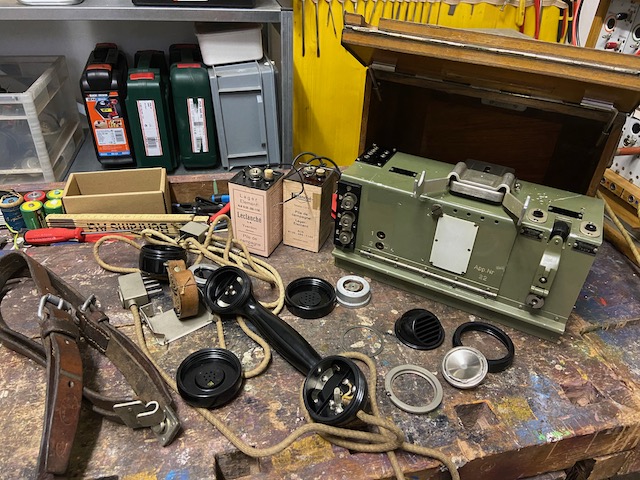
The Swiss Army field phone "ATf 32: Armeetelefon Modell 32" was developed by Telephonwerke Albisrieden A.G., Zürich (The Swiss Siemens subsidiary since 1922, later renamed to Albiswerk Zürich AG, then to Siemens-Albis AG and finally to Siemens Schweiz AG), in the early 30ies. The goal was to replace the current lineup of Swiss army field-phones which were all based on Siemens & Halske designs from the 1910s. Compared with the German Feldfernsprecher 33 developed during the same time by Siemens & Halske the ATf 32 has a very conservative design, nearly double in weight and volume and still using a straight forward simple speech coil setup and not the more advanced anti side-tone setup all-ready used by the FF33 and most civil phone setups of that era.
The design was licensed to other Swiss telephony equipment manufacturers, Hasler (Bern), Autophon (Solothurn) and Zellweger (Uster), together with Telephonwerke Albisrieden they delivered >12000 pieces between 1932 to 1946. The first batch of about 1000 instruments was painted green/grey (body and wooden box), on the later models the body was painted black and the oak box clear-coat painted. The model in the video above is from the early manufacturing batch made by Telephonwerke Albisrieden A.G. in 1932 with serial #22. In the gallery below there are also pictures from a late model made by Autophon in 1945 with serial #10996. The instruments were in use by the Swiss army from 1933 up to 1970.
Short description from the Swiss army handbook for the ATf 32: "The army telephone model 32, referred to briefly as A. Tf. 32, is a further development of the C telephone. Simplified operation and increased speech performance are the most important improvements over this older model. The A. Tf. 32 is an instrument built according to the local battery system, which can be connected to both single-wire and double-wire lines. It may be used in local battery, central battery and automatic systems. The A. Tf. 32 can be used both as a fixed intercom or as a service telephone of a Vermittlungskästchen based switchboard, as well as for line construction and when searching for line faults. If no switchboard equipment is available, a makeshift switchboard can be created with several A. Tf. [...] The body and all accessories are installed in a solid oak box with a hinged, two-part cover. Metal protective corners and edge strips protect the box from damage. The belt hook is located on the upper side and belt locks on both sides for attaching the adjustable shoulder strap. The device can be carried as a side or back load. On the right side there are two protruding rivets into which the dial add-on can be mounted. The lid, which is closed by two lateral snap-in brackets, can be placed in any position when open, in order to serve as a rain cover for the handset when operating outdoors. The inside of the cover has two circuit diagrams of the apparatus. [...] The body is fastened in the box with two captive screws on the back. The patch-cord is stored in two blind pawls fixed inside the box. The headphones are held by a removable support. Special stop blocks with compression springs are used for the mounting of the handset."
For the handset the Swiss PTT Standard Modell 1931 is used (a very modern choice in 1932). As the instrument uses a hookswitch no P.T.T. button is added to the handset. The handset uses the PTT standard size RX elements and the Lorenz type carbon TX elements. As these instruments were in use up to 1970 the TX elements were later replaced with elements of PTT standard size type 1946 using adapter rings. The headset uses the same RX element and is put in series with the handset RX when connected. The headset socket has a built in contact which closes the circuit if the headset is not plugged in.
The buzzer used is a Telephonwerke Albisrieden development specific for this instrument which was later reused in different other field line instruments like the Feldtelephon Modell 41 and the Pionierzentrale Modell 37 (Field switchboard). The buzzer is combined with the speech coil, built into a dust-proof bakelite housing which is not intended for field repair (From the Swiss army handbook for the ATf 32: "Opening the buzzer by the troops is prohibited."). The buzzer adjusting screw is accessible without opening the buzzer housing and allows adjustment from ~450 to 550Hz.
Line sockets allow to build a small field switchboard with multiple ATf 32. Socket #1 is to be used to connect the instrument to a line from another instrument, socket #2 to connect another instrument to the local line (the local instrument is disconnected from the line when a plug is inserted into socket #2). A respective patch cord is available in every ATf 32.
The optional external dial unit Wählerzusatz 32 is contained in it's own wooden box (also painted green for earlier models and clear coated for later models) and can be mounted to the side of the main instrument box. The dial unit is connected to the automatic network line and then with the patch cord to socket #1. The dial installed is a Swiss PTT standard Zenith dial. Earlier models use the type 4 dial, and later models the type 5 dial which was introduced by the Swiss PTT in the mid 30ies. The type 5 dial adds an additional shorted out dial pulse to increase the pause between individual dialled numbers and in such way decrease wrong dialling (with a type 4 dial if dialling e.g. 1 - 1 fast sequence it might be interpreted as 2 by the CO equipment, with the additional dial step there is always a forced pause of 1 dial pules length between dialled numbers).
Disassembled.

Ready for use.
The handset on-hook. The generator handle in it's working position.
Headset and patch-cord ready beneath the instrument.
The lid in it's most open position.
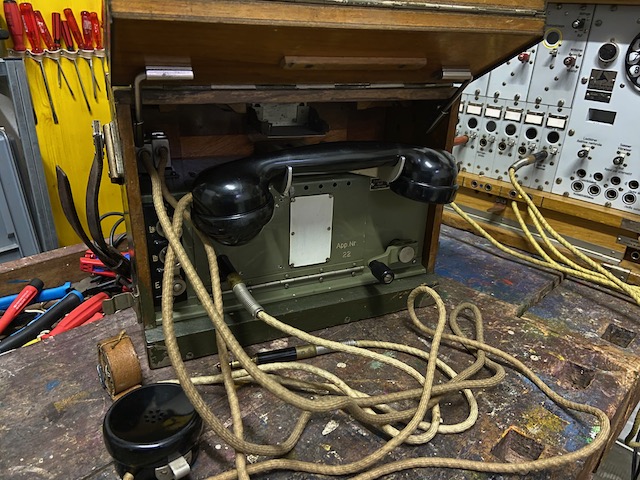
Closed for transport.
On the front the model indication and the serial number.

On top the bracket to clip in the leather carrying belt, the manufacturers logo (Telephonwerke Albisrieden) and the production year 1932.

From the back.
The belt mounted for backpack style transport.
For transport on the side the belt can be unclipped on the top.
The two screws visible are the captive screws which hold the body inside the box.

The diagram.
On the left the wiring- and on the right the functional diagram.

Front of body.
On the left the binding posts for La, Lb and E.
For a single wire with earth return setup there is a latch to connect Lb to E.
Socket #1 is used to connect the instrument to another instruments line, socket #2 connects this instruments line to another instrument.
Behind the front door is the battery compartment.
On the front door left was the former Swiss spelling table which has been removed in the 50ies when another spelling table was introduced.
Beneath a white labe to mark the line information and the instruments serial number #22.
On the right the folded in generator handle.
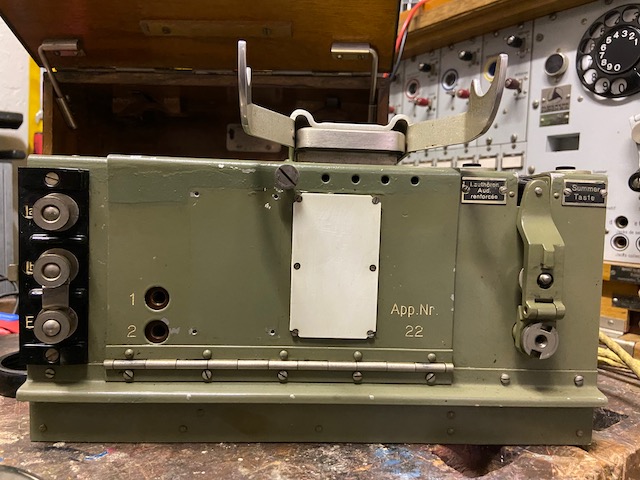
The body from the top.
On the left the 4 prong handset and the two prong headset sockets.
In the middle the slide out handset cradle.
On the right the "increase volume" button and to the right the buzzer button.

The body from the back.
To the left and right of the ringer the capacitors.
On the left the generator.
On the right in the black bakelite case the buzzer/coil setup, the big screw in the middle of it is for buzzer frequency adjustment.
Between the ringer and the buzzer mounted to the bottom two spare lightning arrestors.
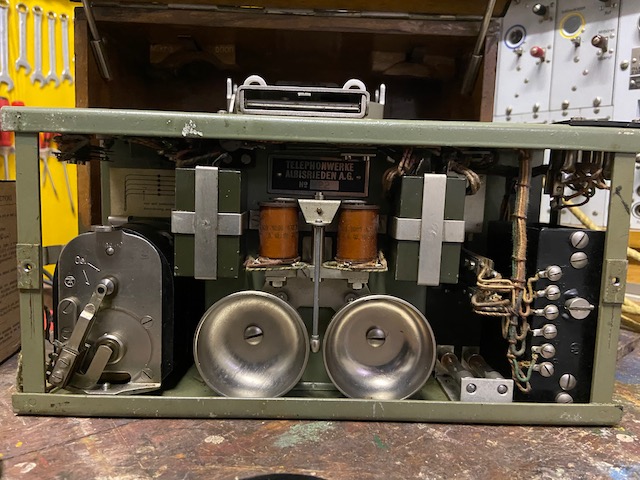
The battery box open.
On the left the lightning arrestors for La and Lb.
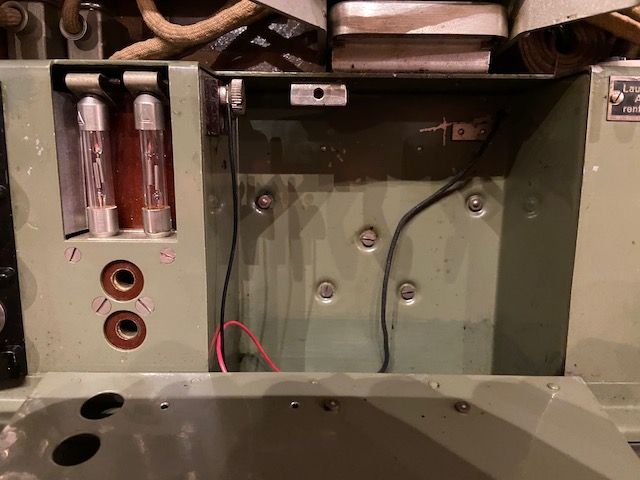
The 1,5V, Swiss Leclanché Lagerelement inert zinc-carbon batteries.
The left one is unused, the right one was activated (produced in 1979, activated in 1987).
On the unused one the unbroken glass-tube is visible, that has to be broken to let air in and through the hole closed by a cork tap water has to be added to activate the electrolyte.
Leclanché produced these batteries up to at least the late eighties (the newest in my possession is from 1989), as the successor of the ATf 32, the ATf 47 was in use by the Swiss army until 1998.

Handset and headset.
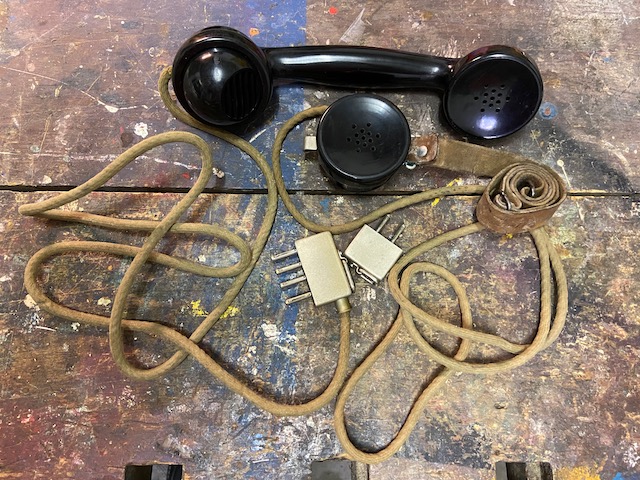
The handset and headset opened.
This handset was originally built for Lorenz type TX elements.
An adapter ring was added to be able to use more modern PTT type 1946 TX elements.
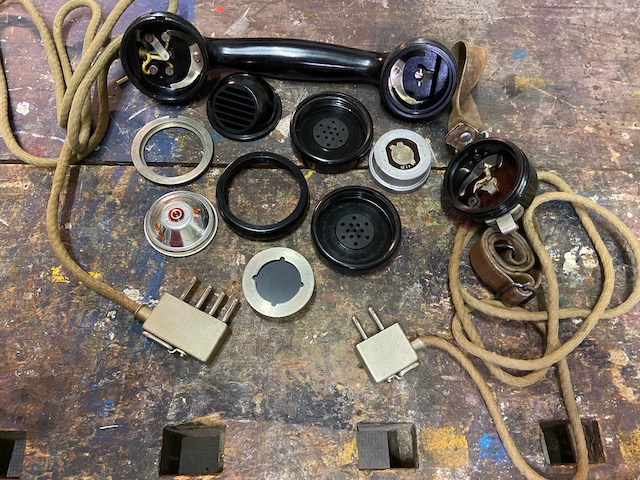
Back of the RX elements.
One is made by Autophon (stamped 4.7.38) the other from Zellweger (Uster).

Back of the TX element.
Made in 1966 by Zellweger (Uster).
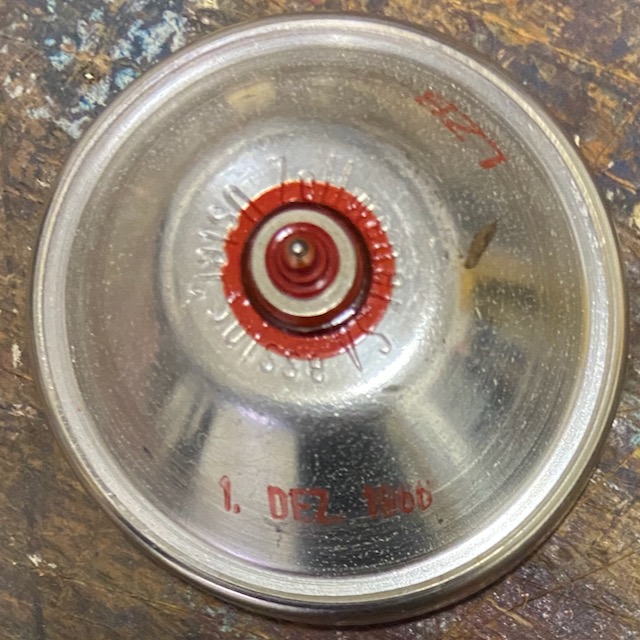
The empty box.
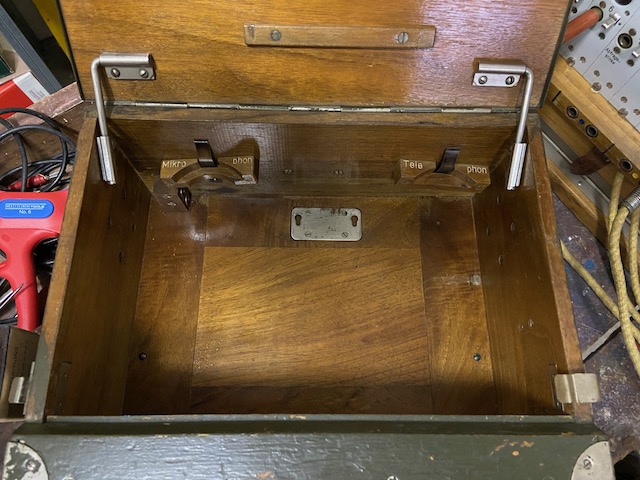
Body and headset clamp mounted in box.
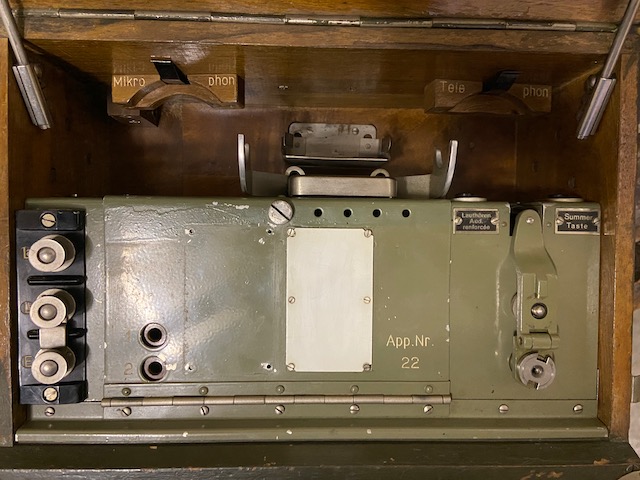
Patch cord stored.

Headset stored.
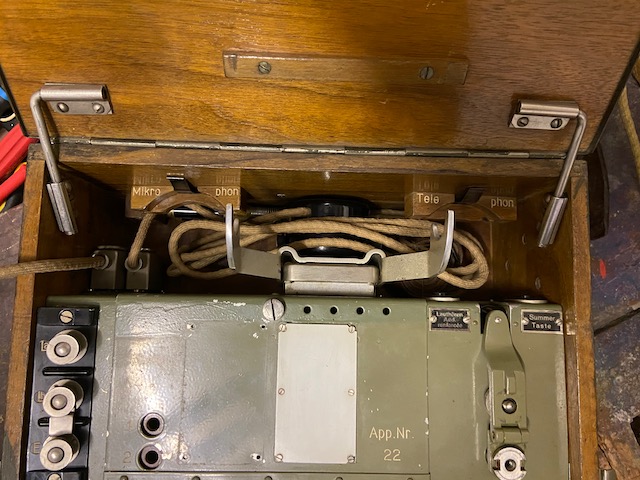
Handset stored.
Ready to close
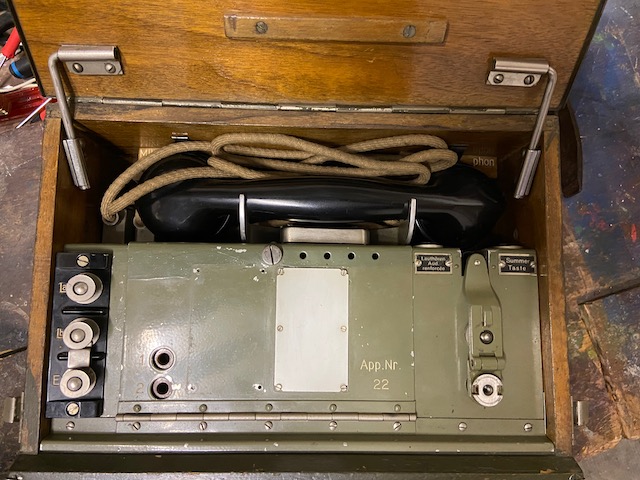
Half of the lid open.
The diagram mounted to the lower lid inside.
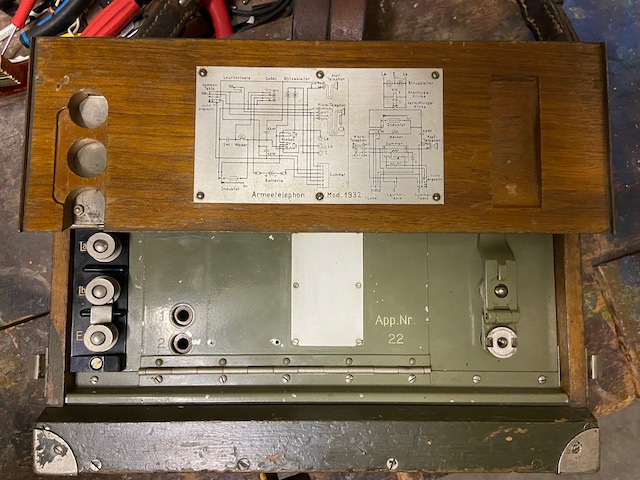
The optional dial unit.
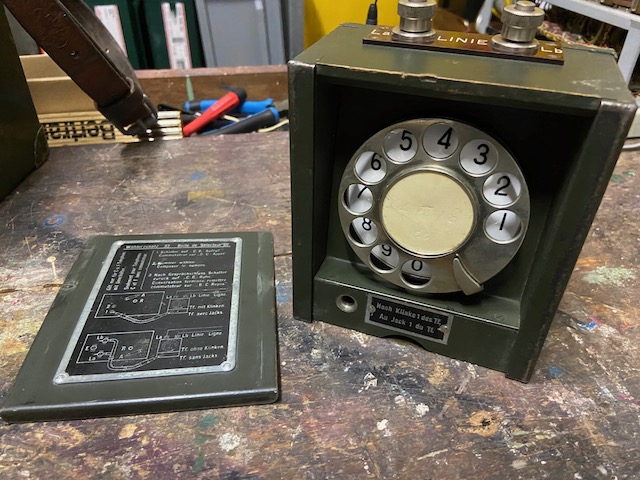
The dial unit open.
Back of the dial.
It is a Swiss PTT standard Zenith dial type 4.
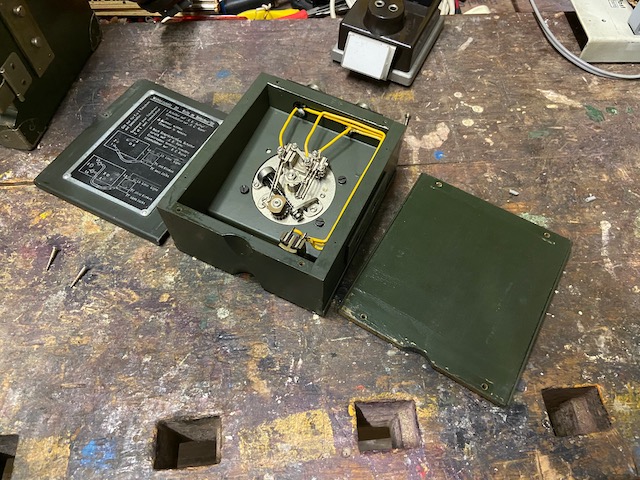
The dial user guide.
The dial is thought to be also used with the older Swiss field instruments: Feldtelefon (1909, 1925) and Central Telefon.
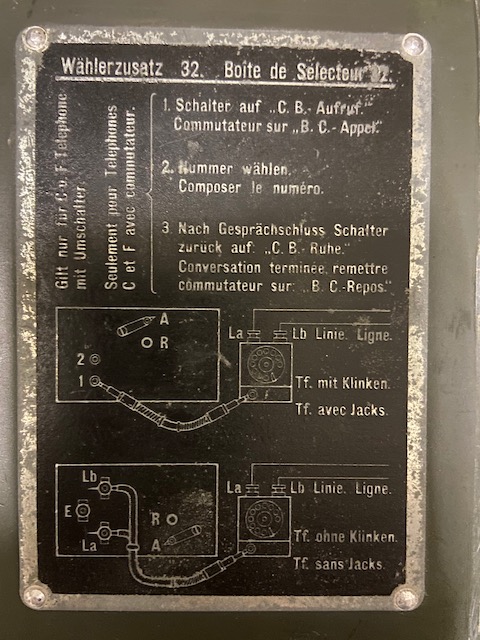
A newer ATf 32.
Body black, box clear coated.
The rest is electrically and mechanically identical to the early green version.
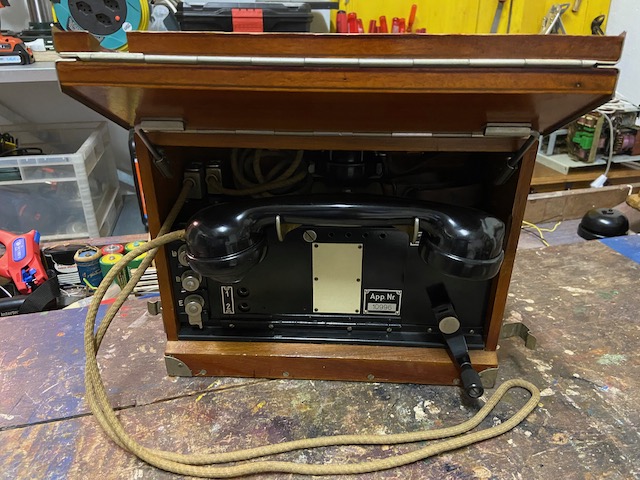
Modell 1932, Serial #10996.
In front a newer dial unit.
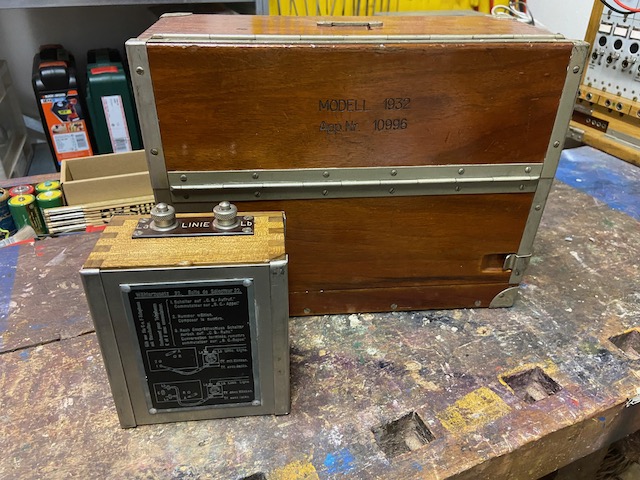
This one is built in 1945 by Autophon.

The diagram also virtually identical to the older one.
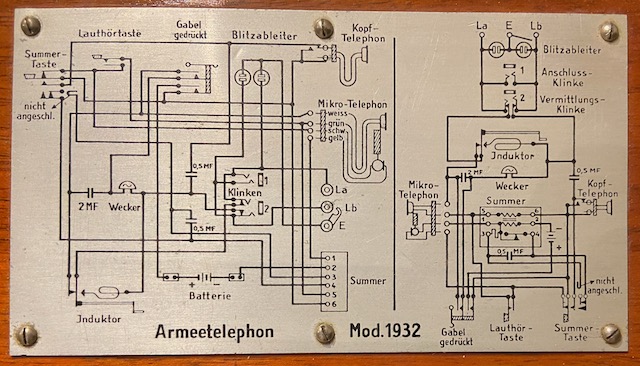
The newer dial unit uses a Zenith dial type 5. The numbers are closer together to make space for an additional click below the one.
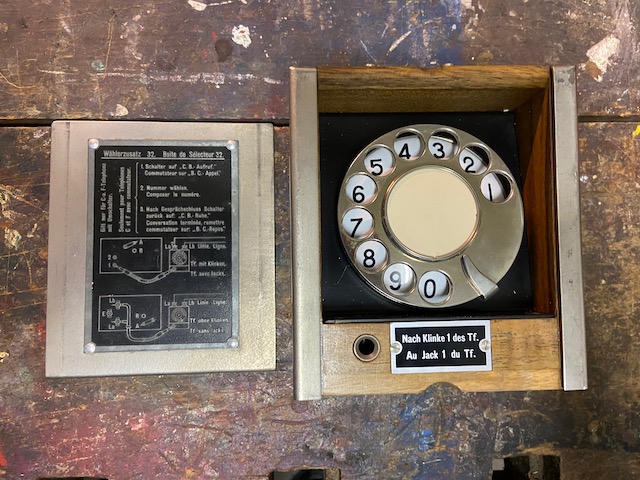
Creative Commons Attribution-ShareAlike 4.0 International License